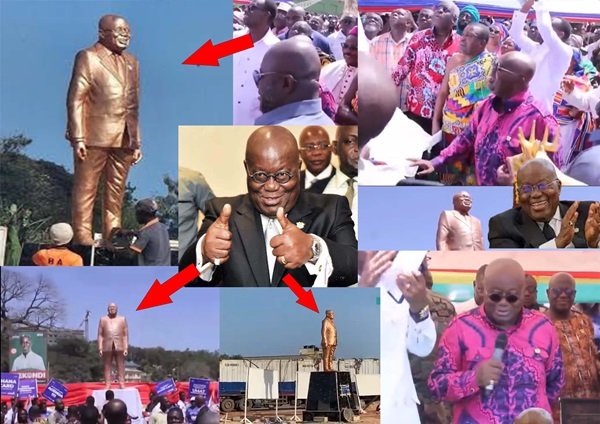Nana Addo Unveils Self-Dedicated Statue: Ghanaians React with Mixed Emotions
Recently, Ghanaian President Nana Addo Dankwa Akufo-Addo unveiled a statue built in his honor, stirring a lively conversation across the nation. The unveiling ceremony, held in Accra, showcased a beautifully crafted statue that aims to celebrate his contributions to Ghana’s political landscape and development. The statue’s design and the president’s choice to be honored in this way have sparked diverse reactions from citizens and political analysts alike.
The Unveiling Ceremony
The unveiling took place at a well-attended event featuring government officials, diplomats, traditional leaders, and members of civil society. The statue, strategically located in a prominent public space in Accra, portrays President Nana Addo in a dignified, statesman-like pose, reflecting his role as a leader. The statue was reportedly designed by a prominent Ghanaian sculptor known for creating tributes to national figures, and it incorporates several details symbolic of Nana Addo’s vision for Ghana.
In his speech, President Akufo-Addo emphasized that the statue is not just a personal tribute but a reflection of Ghana’s journey towards progress and self-reliance. He expressed hope that the statue would inspire future generations to pursue positive change, saying, “This is a monument not only to my legacy but also to the resilience and spirit of every Ghanaian.”
Symbolism and Artistic Features of the Statue
The statue stands on a large base engraved with symbols representing Ghana’s heritage, unity, and commitment to democracy. Nana Addo is depicted in traditional kente cloth, highlighting his pride in Ghanaian culture. Around the statue are smaller carvings depicting significant achievements from his tenure, such as the Free Senior High School (SHS) policy, Planting for Food and Jobs, and One District, One Factory initiative.
Art enthusiasts have noted the attention to detail in the statue, calling it a tribute that captures the president’s political journey. However, the decision to erect a statue during Nana Addo’s presidency has generated a mix of opinions on social media and beyond.
Public Reactions: A Nation Divided
The statue has sparked varied reactions from Ghanaians, with opinions largely divided along political and social lines. Supporters view the statue as a well-deserved tribute to a leader who has implemented impactful policies and initiatives. Many believe that Nana Addo’s policies, particularly in education and agriculture, have had a transformative impact on the country and that a statue in his honor is fitting.
However, critics argue that erecting a statue in his own honor while still in office is premature and sends the wrong message about leadership priorities. Some citizens believe that such monuments should be reserved for former leaders and individuals who have left an indelible mark on the country after they have stepped down from office. They argue that resources allocated to the statue could have been used to address pressing issues, such as infrastructure development, healthcare, and poverty alleviation.
One critic stated, “A statue is a luxury. Our communities need water, electricity, and good roads—not monuments. A leader’s legacy should be based on the impact they leave behind, not on statues they build for themselves.”
Opposition Responses
Members of the opposition have also weighed in on the unveiling. They argue that while Nana Addo’s administration has indeed made strides, it has also been marked by challenges, such as rising unemployment and concerns about national debt. Some opposition figures claim that such a self-celebratory gesture risks appearing tone-deaf amid economic hardships.
Despite this, others within opposition circles have adopted a more neutral stance, suggesting that while the statue might be viewed as premature, it could still serve as a reminder to leaders to prioritize initiatives that resonate with the citizens they serve.
The Larger Debate: Monuments and Legacy
The unveiling has reignited a broader discussion in Ghana about the role of monuments in shaping historical narratives and honoring leadership. Throughout Ghana’s history, statues have been erected to honor individuals like Kwame Nkrumah, the first president and a key figure in the country’s independence movement. Nkrumah’s statue, for instance, was installed long after his contributions had left a lasting impact on Ghana and Africa as a whole.
While some feel Nana Addo’s statue is a break from tradition, others see it as a contemporary way to celebrate leaders while they are still alive to witness it. The debate also touches on the significance of such symbols in a society where people seek practical, immediate benefits over symbolic gestures.
President Nana Addo’s Vision for the Statue
In his concluding remarks at the ceremony, Nana Addo stated that the statue should be viewed not just as a tribute to his leadership but as a testament to Ghana’s progress and aspirations. He mentioned that while some might view it as controversial, his intention is to inspire all Ghanaians to contribute positively to the country’s growth, regardless of their political affiliations.
“The statue is a reminder of our collective strength and resilience,” he said. “I hope that it stands as a beacon, inspiring not just my legacy but the legacy of Ghana’s future leaders and citizens.”
A Monument with Mixed Meanings
The unveiling of Nana Addo’s statue has undoubtedly sparked a conversation that goes beyond the statue itself. It has revealed the varied expectations that Ghanaians hold for their leaders and how symbolic actions can resonate—or clash—with public sentiment. As the debate continues, the statue stands as both a representation of Nana Addo’s impact and as a conversation starter about leadership, legacy, and the priorities of a developing nation.
Time will tell whether the statue will ultimately be seen as a cherished tribute or a symbol of misplaced priorities. For now, it remains a striking addition to Ghana’s capital, capturing the complexities of leadership and the diverse perspectives of the people it serves.
Thank you for reading.

